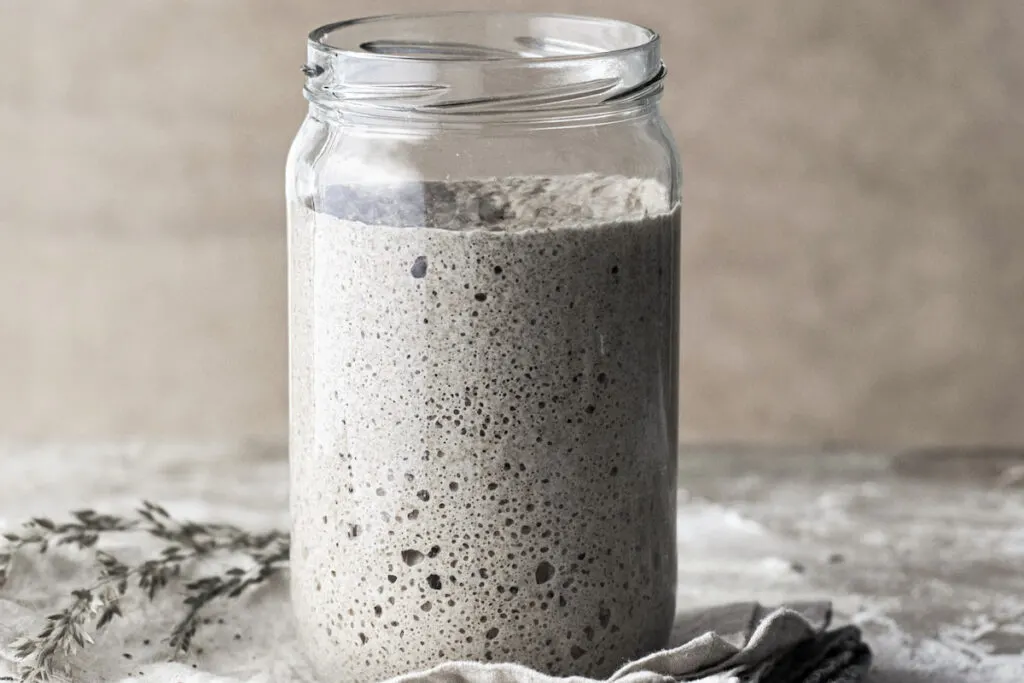One day your sourdough starter is bubbling away nicely. The next, you notice black, white, or grey spots growing on it.
These spots are called mold and are not the kind of growth you want in your starter. Why does mold grow on a sourdough starter? And what can you do about it?
Mold can grow on your sourdough starter for two main reasons. Either you have neglected the sourdough starter, or something is contaminating the starter. You should probably throw out a very moldy starter. However, if there is a little mold growing on the surface, you can remove it and still use the sourdough starter.

Although mold growing on a sourdough starter is uncommon, it is vital to recognize what mold looks like as it means there is a problem with your starter. The yeast in sourdough starter is a living organism, so it can be unpredictable.
On the one hand, you need to keep the starter fed and in a warm environment to get the yeast to grow. On the other hand, incorrect feeding and too warm and moist an environment can lead to mold growth on the starter.
How can you avoid this moldy situation from even happening? And can – or should – you save a neglected or contaminated sourdough starter?
Table of Contents
What is mold?
Just like the yeast and bacteria that keep your sourdough starter active, mold is a living organism. Molds are microscopic fungi, which appear as fuzzy grey, black, white, green, and even pinkish-purple spots.
Mold thrives in moist, warm conditions is usually relatively harmless, existing all around us. However, some people are allergic to mold, especially mold that aggravates respiratory diseases.
Mold on food causes it to decay – and rotten food can be toxic.
How do I know if there is mold on my sourdough starter?
You will notice mold on your sourdough starter immediately. There will be blackish or whitish spots growing on the surface, or pinkish-orange streaks.
If you leave the mold, it will grow all over the starter. The sourdough starter will also have a funky, unpleasant smell – not the typical yeasty smell of a healthy sourdough.
Why mold develops on a sourdough starter
Your sourdough starter is warm and moist, which is an inviting environment for mold.
Usually, mold does not grow on a sourdough starter because the naturally developing yeasts compete with other bacteria and fungi and prevent them from growing. In other words, a mature sourdough starter can ‘defend itself’ against mold.
There are various reasons why mold grows on your starter.
- Most likely, your sourdough starter is contaminated by food or soap residue, usually because your utensils or the container was not completely clean, your hands were not clean, or a fly got into the container.
- You have neglected your sourdough starter by not feeding it enough or not feeding it correctly., which means that the yeast is weakened and cannot overcome the mold ‘intruders’. Weak yeast can occur in a young sourdough starter, which has not developed the ‘defenses’ of a mature sourdough strain.
- Your ingredients – flour and water – are contaminated.
- The sourdough starter is near a mold source, such as a bowl of fruit with fruit flies.
- Your environment is very humid, which encourages the growth of mold.

What to do if your sourdough starter has mold growing on it
Be very careful if your sourdough starter has mold growing on it. Use your judgment to decide what will be safest. Always err on the side of safety.
If the mold is only on the starter’s surface
If there is only a tiny bit of mold on the starter’s surface, you can skim off the mold and reactivate the starter as described below.
Salvaging your starter in this way is recommended only if this is a mature or ripe starter – do not try to reactivate a young starter, as it probably has not developed a strong enough yeast strain to fight off mold again.
If there is mold growing on the container, but it has not reached the starter, you should scrape it off and follow the steps below.
How to reactivate a starter with surface mold
If you decide that the mold has not spread very far, you can salvage the sourdough starter by following these steps.
- Carefully skim the mold off the surface of the starter with a sterilized, stainless steel spoon.
- Spoon out a small amount of the starter that was not in contact with the mold. Discard the rest of the starter.
- Put the recovered starter into a fresh container.
- Feed the starter according to the one part water, two parts flour ratio.
- Mix the starter, water, and food, then cover.
- Allow the starter to proof for about 12 hours.
- Continue to feed the starter as usual.
- If there is no sign of mold within a day or two, you can safely use the starter for baking.
If there is mold covering or growing under the starter
If the mold has grown beyond the surface of the starter, throw out the sourdough starter immediately.
Instead, begin by making a new batch of sourdough starter or purchasing a starter. Wash and sterilize the container very thoroughly.

How to prevent your sourdough starter from going moldy
It is pretty easy to avoid mold growing on your sourdough starter. Work through this trouble-shooting list if mold continues to grow.
Are you feeding your starter properly?
- Feed your starter frequently to keep the naturally occurring bacteria healthy. You can feed a sourdough starter every 12 to 24 hours.
- Never let your starter get too hungry before feeding it.
- Remember to feed the starter on schedule, not randomly.
Are you working hygienically?
- Use clean kitchen equipment and sterilized or scalded containers. If you have had a mold problem, make sure that you wash and sterilize the jars and equipment you used for the starter before using them again. A hot cycle on your dishwasher will be good enough.
- Use stainless steel, not copper, wooden, or aluminum spoons.
- Always wash or sanitize your hands before working with food.
Is your starter safe from environmental contamination?
- Make sure your sourdough starter container is covered.
- You can cover the starter with an airtight lid to avoid it getting contaminated by mold spores or insects that carry mold. However, always allow for enough space for the starter to grow, or it will break or burst out of the container.
- Move your starter to another room if you think the location is a problem, for example, if it is too warm and humid or near a contamination source.
Are your ingredients free from contamination?
- Remember that your flour is your sourdough starter’s food, so it needs to be of good quality for your starter to thrive.
- If mold persists, your flour could be old or contaminated. Throw it out and begin with a fresh batch of flour.
- Unbleached, chemical-free, organic flour is best for sourdough starters.
- If the flour is not the problem, perhaps your water is. Use bottled water free of chemicals or chlorine to prevent any contamination.

Can I get sick from a moldy sourdough starter?
You can get sick if you eat the moldy sourdough starter or dough itself. Remember never to eat raw dough of any kind.
If you use a moldy starter for baking, the bread will not rise and will not be suitable to eat as the yeast is too weak. You can get an upset stomach if you eat this bread.
Conclusion
It is unusual for mold to grow on a sourdough starter because the natural bacteria prevent mold from growing. However, mold can develop if the starter has been contaminated or neglected.
You can salvage a moldy sourdough starter, but it is probably safer to start from scratch. Always work hygienically, with the best possible ingredients, and maintain a regular feeding and care schedule for your sourdough starter.
